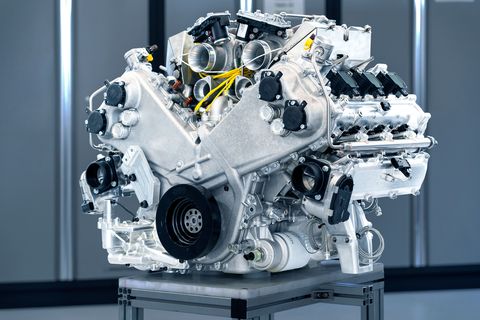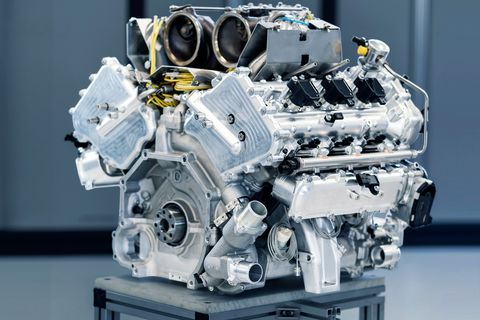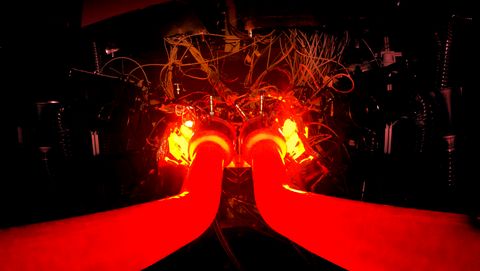Aston Martin is looking to take its engine-building, or at least a good part of it, in-house, and it’s doing so with a new hybridized 3.0-liter turbocharged V6 that will replace the AMG-sourced V8 it uses widely.
Specs are still sparse (by which we mean virtually nonexistent), but Aston has confirmed that the engine, which will be codenamed TM01, will make its debut in the upcoming midengine Valhalla—a sort of Valkyrie Jr.
According to the automaker, “The final power and torque figures for each application of this powertrain will be determined by the desired characteristics of each product it serves and confirmed at the time of launch.” In other words, wait and see—but expect that, in at least one configuration, it will be the most powerful power unit Aston has used to date.
The TM01 engine uses a “hot V” configuration, which most broadly means that the engine’s exhaust manifold is located inside the “V” of the engine, and the intake on the outside—the opposite of what you’d see on a typical, traditional V engine. Often, but not always, this is done to enable compact integration of turbochargers, since you can tuck them right in the valley of the block.
In developing this engine, Aston says it has drawn from its experience with the 6.5-liter V12 in the upcoming Valkyrie; that Cosworth-sourced engine also employs a hot V setup, though it is naturally aspirated. It must have also been paying attention to the AMG-sourced V8s it has been installing in its vehicles for a few years now—those engines use a turbocharged hot V arrangement, too.
To prove this isn’t all vaporware, Aston has shot a short video showing the startup of this new engine in a testing cell. We have no doubt it can make power, but a bigger question is, what does it sound like? Can it compete with a V8, let alone a V12? If you can get it to rev high enough, maybe … but the video doesn’t give much away.
So yes, concrete specs are scare, but beyond that, we know that it uses a dry sump for lubrication, which will let Aston place it lower down in the vehicles it powers. It’s tough to tell from photos, but its block appears to use a V angle wider than 90 degrees, which should also result in a power unit with a lower center of gravity. It has been engineered for electrification from the get-go; it will be paired with a “new range of hybrid systems,” presumably of varying output levels.
Also, it should weigh under 440 pounds—about 20 pounds lighter than the V8 it replaces (though, obviously, its two-cylinder diet probably has a lot to do with that).
There is one other little detail: The powerplant’s internal designation, TM01, is a reference to Tadek Marek, the Polish engineer responsible for the refinement of Aston’s Lagonda-sourced inline-six motor in the postwar years and the development of Aston’s acclaimed straight-six engines of the late 1950s and 1960s; his eight-cylinder engine, which went into production on the Aston Martin V8 in 1969, remained in use until 2000.
Aston has leaned on outside sources for its engines ever since, even if it did modify them to meet its specific needs. As this new V6 is an in-house development, the first since Marek’s days, it seems fitting that its name brings things full circle, commemorating the man who designed the marque’s last in-house engines.
Source: Read Full Article




